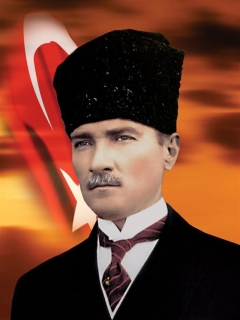
"The Turkish State, having the eminent and greater part of its boundaries as the sea, is to have also an eminent and great navy. The Turkish State will then be more appeased and secure."
First school which forms the Naval Academy's basis was founded under the name of ''Naval Engineering Golden Horn Naval Shipyard'' during the reign of Mustafa III in1773. It was rather a course providing education to civilian captains of merchant marine as well. In this course, given onboard of a galleon anchored at Kasimpasa, Plane Geometry and Navigation were taught.
According to Memories of Baron de Tott, which were published after his returning to his country, in 1773 he was appointed for establishment of a Naval Shipyard Mathematical College on the command of Hasan Pasha during the reign of Sultan Mustafa III, who was a believer of the fact that science and education must have become widespread. The trainees who were advanced in age, even the captains with white beard had reached to a capacity within three months that they were able to measure altitude, practice the four rules of the plane geometry over the land, and plot a route. This training ended as it was sufficient for the trainees in their sixties and Sultan Mustafa III and Baron de Tott decided that this education would be consumated by practices in course of time.
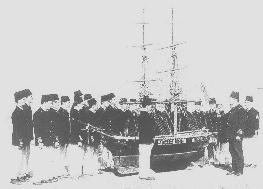
Mekteb-i Fünun-ı Bahriye-i Şahane'de Bir Ders (Bahriyeli Ali Sami'nin 1900'lü yıllarda çektiği bir fotograf)
First Naval School, established on land by Baron de Tott's advises and endeavors of Hasan Pasha, was founded in Kasimpasa, under the name of " Mathematical College " or " Naval Mathematical College" on February 1776. The Mathematical College in the shipyard was so small and didn't meet the requirement. Thus a new mathematical college with several rooms started to be constructed on about the same place where the galleons with three holds were constructed. The school that would give three- year education, started training in its new building under the name of "The Imperial Naval Engineering School" on October 22,1784. Naval Engineering School was divided into two divisions. In the first division, Navigation and Plotting oriented education was given, and in the second division cadets were educated for being Naval architecture officers.
Naval Engineering School was burnt in a conflagration setting some parts of Kasimpasa on fire in 1821, and it was transferred to reconstructed Errehane (sawmill) building around Parmakkapi in the shipyard in 1822. When Sultan Mahmut II came to Divanhane ( imperial hall of audience) for a stone pool construction at the place which is known today as Tas Havuzlar ( Stone Pools), He was said that the building in Parmakkapi was unsuitable for education, and according to his imperial order the construction of a seperate school was conformed. Until the construction completed, transfer of Science of Navigation division to Heybeliada, as a temporary solution, was decided.

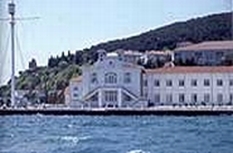
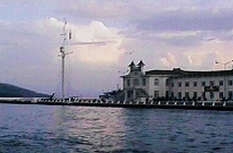
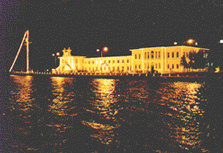
Old campus of the Turkish Naval Academy. Now serves as the Naval High School
During the days that the school was moved from Heybeliada to the new construction at Kasimpasa in 1838, it is understood from the code of laws promulgated over the school that the education and training activities were commenced with an effective program. The school, called "Naval School " after the Reformation, functioned in Kasimpasa for 12 years then was moved again to Heybeliada for the last time. The school had 34 rooms and 150 trainees. Furthermore a 30-bed hospital, a pharmacy, a printing house, a book binder's shop, and a very big library were available. English training system was followed and some lessons were even taught by English instructors. In that period, in addition to the name "Naval School", the school was also called "Naval School The Great", "Naval Technical School" and "Naval Technical School The Great".
In the reign of the Sultan Abdulaziz the number of the trainees registered was increased and the education was improved. The training programs were handled again parallel to technological development of the century, and a steam division- to operate the steam engines, was added, in addition to the Deck and Naval Architecture divisions. Thus, the Naval School had an aspect of a school giving 8-year education, 4 years of which in Naval High School and 4 years at the Academy. After the Second Constitution Period, an upgraded education system, adapted from British Naval Academy, was applied in 1909.
During the years of the Balkan War, the educational system was modified. Hence, four-year Naval School graduates were educated for three years onboard the school ship as engineers. After that, they would assumed their duties by being promoted to Lieutenant Junior Grade. Thus the school, called "Island School", had the property of being most significant school of Turkey with respect to both educational system and social life. It is seen that in Republic Period the cadets admitted to Naval School were to be educated over deck, engine, and secretary divisions. The training term for deck and engine divisions was four years, the first year of which was the preparation period. Cadets that could graduate at the end of this period, underwent a course for another year, after then, they commenced their duties in the Navy by being promoted to engineer (ensign).
Heybeliada Naval School was given the name of "Naval High School" by the command of General Chief of Staff on 27 May 1928, and the curriculum of military schools was applied in the new education term beginning on the first of August. This new education and training system, began in1928, was applied for two academic years. Naval High School and Naval Basic School were re-united at the facilities of Heybeliada under the name of "Naval Academy and High School". When the Second World War started in 1941 and Germans began to occupy Balkans, the transportation of the Naval Schools to Anatolia was necessary. And on May 23, Naval Academy and High School were transported to Infantry Barracks in Mersin. Naval Academy and High School located in this place unsuitable for education until 9th of September, 1946, when it was transferred back to Heybeliada.
Educational period of the Naval Academy was two years until 1953, one year being theoretical and one year being practice in the Navy. In 1953 four-year line system, having education, first two years of which as cadets and the other as officers was started to be applied. In the1969-1970 Academic Year, education of Naval Academy was re-organized to train cadets in the first three years of education and to train officers in the last year. In the 1970-1971 Academic Year, it was organized again as giving education to officers in the school under the name of "Basic Division School". In 1974, by the command of General Chief of Staff, duration of education arose to four years. Thus, educational system of the Naval Academy was given a new form with Electric-Electronics / Engine and Electric / Electronics (Communication, Computer, Control Electric) branches, and first officers trained with this system graduated in 1978.
Educational system of the Naval Academy was overviewed again in 1984, parallel to the developments in science and technology. Operational Research and the Management, Engine and Electric, Electronics (Communication, Computer, Control, Electric) branches were decided to be added by the 1986-1987 academic year. Turkish Navy's increasing demands over personnel, and place due to the requirements of continuously improving educational system as well as the transportation problems, transfer of the school to a more convenient location arose as a necessity. Therefore, construction process of a new campus started on Tuzburnu Peninsula by commandeering a 3000-acre land. The foundation was laid by Fahri KORUTÜRK, the president of the day, who was also an alumnus of Naval School on July 28 1977.
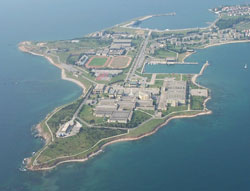
Modern campus in Tuzla
The modern Naval Academy, which is the pride for the Turkish Navy, was opened by Kenan EVREN, the president of the time, and the foundations on Heybeliada were left to the Naval High School Command. First officers from three scientific branches graduated in 1985-1989 Academic Year. At the beginning of 1990, the status of academies and the BSc concept, which took place in the second item of article 1462 of the Academies Law started to be discussed.
Parallel to the orders of the General Chief of Staff, the graduates of the Armed Forces Academies are to be granted a Bsc degree without requiring any further studies in post-graduate programs. Deregulation of the present programs, coordinated with respect to the above mentioned order was put into practice by examining the engineering programs of Supreme Education Council of Bogaziçi University, Istanbul Technical University, Middle East Technical University. Accordingly, a new engineering program was applied in 1991-1992 Academic Year starting from the first and second classes, and the first officers, educated in this program, graduated in the 1993-1994 Academic Year.
Admission of female nominees, graduated from civilian high schools started in the1992-1993 Academic Year. According to Military Training Cooperation Agreements signed with friendly and allied countries, students, especially from Turkic Republics as well as Albania and Pakistan were admitted in the 1993-1994 Academic Year. Control and electronics engineering branch, which was a sub-divison of electric/electronics division, was separated as control systems and computer engineering in the 1993-1994 Academic Year starting from the second class.
By the1995-1996 Academic Year a new educational program called GAYE 2000 was applied starting from the first class. With this program, Naval Academy's curriculum became harmonious with STCW-95 agreements (international midshipman educational program). Moreover, the number of professional and foreign language courses was increased, total credit hours were decreased from 205,2 to 192,5, graduation project became two-semester course, information and meteorology courses were added, combat physical training of the first classes started to be performed before 15.30. In order to train marines and engineers, a number of nominees from civilian high schools were admitted to first class from the beginning of the1995-1996 Academic Year, but in the following years this admission process was ended. On the other hand, a group of officers for marine and engineering corps were commissioned from the graduate class of the 1997-1998 Academic Year.
The graduates of the 1996-1997 was granted a BSc diploma in engineering in addition to the diploma of the Naval Academy. In accordance with the article 4566, the law of military academies, issued on May 17th,2000, restructered the deanship organization. In this content, the position of named for the Dean of Academics was renamed as the Deanary, and the branches granting engineering degrees were reconstructed and the heads of major science branches increased from four to nine. Accordingly by the same law, The Naval Sciences and Engineering Institute was founded for postgraduate studies in order to meet the needs of Turkish Armed Forces, starting from 2001-2002 academic year.
"Bu web sitesinde yer alan tüm bilgiler ve duyurular tanıtım amaçlıdır. Bu bilgilerde ve duyuru içeriklerinde Dz.KK.lığı ve Dz.Eğt. ve Öğt.K.lığı tarafından T.C. Anayasası ile yasalara uygun olmak kaydıyla değişikliğe gidilebilir veya yayından tamamen kaldırılabilir." "Sitede yer alan bilgi ve duyurular hiçbir gerçek ve tüzel kişiye mali ve hukuki anlamda kazanılmış hak doğurmaz.Dz.K.K.lığı ve Dz.Eğt. ve Öğt.K.lığının eylem ve işlemlerinde takdir hakkı saklıdır."